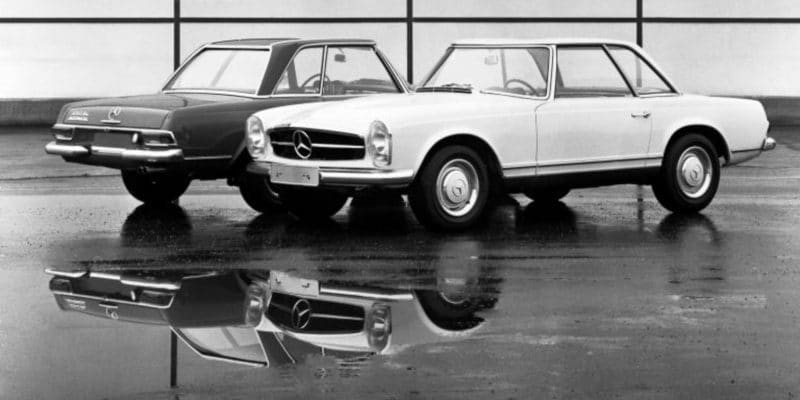At the March 1963 Geneva Motor Show, Mercedes-Benz presented the new 230 SL. The beautiful Gran Turismo from Sindelfingen faced the challenge of replacing two extremely popular sports cars: the 190 SL (W 121) and 300 SL (W 198). Internally referred to as the W113 series, it is said to symbolize high performance and the most advanced features for optimum driving safety. And last but not least: from the very beginning, the W 113 was loved for its extraordinarily elegant design. In three parts we take you to the history of this beautiful Mercedes-Benz. Today you will read part two, in which we describe the shortest and least produced Pagoda: the 250 SL.
The 230 SL had earned its spurs for four years, and Mercedes-Benz thought it was time to replace the Pagode debutant from 1963. On February 27, 1967, Mercedes-Benz presented the successor, which became the 250 SL. From the outside, the new car, whose series production had already started in December 1966, was indistinguishable from its predecessor. The changes were mainly due to the engine and braking system.
Shop in-store
For the technical changes, Mercedes-Benz consulted the characteristics, because the 250 SL adopted the engine and braking system in a modified form from the 250 SE (W 108 III). The M 129 III engine had a displacement of 2496 cc. The power source delivered the same power as the engine in the 230 SL: 150 DIN hp (110 kW) at 5500 rpm. The torque of the 250 SL engine was ten percent higher than that of the 230 SL power source. In addition, the M 129 III engine showed a flatter torque curve. It was fitted with seven crankshaft bearings for smoother operation and also an oil/water heat exchanger.
thermally sensitive
In addition, the piston rings received a molybdenum treatment to reduce the initial thermal problems of the M129 powerplants (still descended from the 180 M1951 engine). The cylinders were arranged in pairs (three times two) and in pairs they were too close together. In addition, they were not separated by cooling channels (or chambers). The top of the pistons simply got too hot under high load. With the molybdenum piston rings, Mercedes-Benz partly solved this (already before the arrival of the 250 SL). As with the M127 engine (including the 230 SL), the M129 engine had a cast iron block, an aluminum cylinder head and a single overhead camshaft. Finally: in terms of chassis, nothing changed compared to the 230 SL.
More balanced and powerful, lower top speed than 230 SL
The 250 SL was therefore more balanced and powerful on paper. The downside was that it didn't quite reach the top speed of the 230 SL due to its higher weight. The top speed of the 250 SL with 195-speed manual transmission was 200 km/h or 1 km/h, depending on the final drive ratio (standard: 3,92:1; optional: 3,69:190; automatic transmission: 195 km/h or 1 km/h). With a five-speed manual transmission, it was available in only one variant (4.08:200), which reached XNUMX km/h.
Disc brakes on rear wheels, brake force regulator
The changes to the braking system meant that the 250 SL also received disc brakes on the rear wheels. Mercedes-Benz fitted larger front brake discs at the front. In addition, the 250 SL received a brake force regulator to prevent overloading the rear brakes. A limited-slip differential was now also available as an option. A fuel tank capacity of 82 liters instead of the previous 65 allowed for a greater range.
California version
The 250 SL was not only available with the three body styles of the 230 SL. Mercedes-Benz also launched a fourth version. The 250 SL was also available as a coupé with a rear seat. This California version was first shown in March 1967 at the Geneva Motor Show. In this version, the necessary space for the rear seat was obtained by omitting the soft top. Since the folding roof could not be retrofitted, this variant promised pure driving pleasure only in dry areas or with the coupé roof mounted.
5196 pieces, only one year in production
The 250 SL became the rarest Pagoda variant, because it was replaced by the 280 SL after just a year. The 250 SL was built 5196 times, and was succeeded in February 1968 by the 280 SL. You can read more about this in part three of this series.


